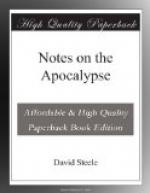We have already noticed, that the symbols in this book are taken from the ceremonial law in part, and part are taken from the works of creation. The heavens and the earth present to our senses a variety of material objects; some more, some less calculated to arrest our attention. Among these, the sun, moon and stars,—earth and sea, mountains and rivers, occupy prominent places. To facilitate our knowledge of these, and prompt reference to any part of them, we generalize or throw them into groups. Thus we speak familiarly of the “solar system,” the “animal, vegetable or mineral kingdom.” Now, just transfer these systematized objects from the material and physical, to the moral and spiritual world. Then consider what relation any one object bears to the system, and what influence it has upon the other objects of which it is a part, and its import may be generally, satisfactorily and certainly ascertained. Thus the same canons or rules which we apply in the interpretation of other writings, will be equally available in “searching the Scriptures,”—never, never forgetting that it is the Spirit of Christ that “guides into all truth,” or his own all-comprehensive rule of interpretation, “comparing spiritual things with spiritual.” (1 Cor. ii. 13.)
In order to the right observance of the divinely prescribed rule, “comparing spiritual things with spiritual,” we must often refer to the prophecies of the Old Testament,—to the second and seventh chapters of Daniel in particular, because that prophet, while the church was captive under the power of literal Babylon, was favoured with a discovery of the purpose of God, that a succession of imperial powers should afterwards arise to “try the patience and the faith of the saints.” As in the case of Pharaoh, so in the whole history of the rise, reign and overthrow of succeeding persecuting powers, Jehovah’s design was precisely the same,—“to make his power known, and that his name might be declared throughout all the earth.” (Ex. ix. 16; Rom. ix. 17.) In connexion with this, he would “glorify the riches of his grace on the vessels of mercy, which he had afore prepared unto glory,” by sustaining them in the furnace of trial.
1. After this I looked, and, behold, a door was opened in heaven: and the first voice which I heard was as it were of a trumpet talking with me; which said. Come up hither, and I will show thee things which must be hereafter.
2. And immediately I was in the Spirit; and, behold, a throne was set in heaven, and one sat on the throne.
3. And he that sat was to look upon like a jasper and a sardine stone: and there was a rainbow round about the throne, in sight like unto an emerald.




